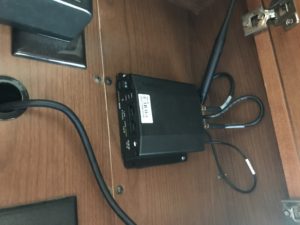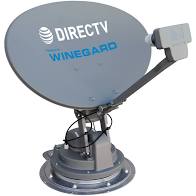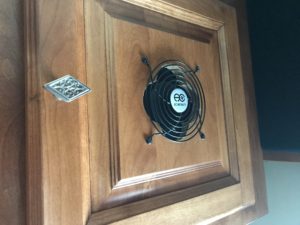IMPORTANT UPDATE – MARCH 16,2021
At the conclusion of the “Cellular Router with External Antennae” section of this article, I mentioned that we were currently with Gypsy Wireless and that we had not been with them long enough to reach a conclusion as to their viability. I want to report that they ended up demonstrating that they were as unreliable and as poorly managed with non existent customer service as Nomad Internet. Our service simply disappeared one day and after countless emails and pleas for help, there was no response whatsoever. We canceled our service and made sure that our credit card company did not pay any attempt to collect any additional funds. We strongly recommend staying away from both Nomad Wireless and Gypsy Wireless. At this point we have gone with another company that has a phone number. The service has not been flawless, but anytime there has been a glitch, I have been able to call or text them and have been able to get a real person, the same person immediately. They have always been able to fix the issue. I will update this when we have had several months worth of experience with them.
In the recent RVlivingfulltime Topic Survey, “Internet Access” got the most votes to be the topic of the next article. So, here goes.
Usually I plan to explore a topic, give some background, some possible ideas to pursue and then give a well documented recommendation.
I want to start off by saying that I will not have a specific, solid recommendation at the end of this article as to a specific source for internet access. This topic is very complex and we have had a several month history of trying to come to a good solid way of accessing the internet. We think we have found it, but it is too soon to give a solid, hands in the air, recommendation.
I want to begin by stating that we are not your typical internet users. We would be called, at minimum , “power ” users. Having said this, we do, however, feel that even the normal internet user can gain from the information we have detailed here.
One of us is an engineer working from home. His main task is working in computer-aided design. For those who might not know what that is, it means that he draws very, very complex detailed designs in 3D using the computer. This type of work requires incredible amounts of bandwidth. The pipeline to the place where this information is drawn from and is saved to, needs to be very wide. Speed is therefore very important as is the amount of data that we can use in a month. We have estimated that we use between 200 and 300 GB per month.
So lets talk about where we have been in searching for this kind of internet service. I am going to start from least viable in our experience to most viable.
Cable Internet
It is important to note that we are talking about internet service that is portable, one that will go with you. It goes without saying that no cellular solution will even approach a cabled solution in speed and in amount of data. If you are going to be in one spot for an extended period of time, and you are in an RV park that has it, then cable internet is by far your best choice. Cable internet is also getting cheaper and a month to month agreement rather than a long term contract is very much the common practice. Installation is a snap; just a wire to your RV and to your router. A router costs around $125. and can be used for all sorts of different suppliers, depending on where you are and what is offered. We recommend you buy one rather than “renting” one from the cable company. This makes more sense economically. This is the one we purchased.
Satellite Internet
Satellite internet still has quite a ways to go before it is an economical solution in several ways. First of all you have to buy the equipment which can run upwards of several thousand dollars. The service itself can run from $50 to $500 a month. One of the problems is that the technology is changing and you could spend $4000 for a really beautiful automated roof satellite dish, only to discover that it is obsolete in a couple of years. Also the speed at the present time is not that much better than cellular and there are of course limits on how much data you can use. We have a beautiful satellite dish on our roof that came with our motorhome. It is fully automated and raises up off the roof on command. Totally useless. It is for Direct TV which we do not use. It cannot with any modification be used for satellite internet.
Local Hot spots
This solution, we have found through lots of experience, is the least reliable and the poorest in quality. To be honest, we have only been in one RV park in lots of travels that had a somewhat decent WIFI and internet access. This park was the KOA in Petaluma, California. It was truly amazing and unexpected. Use of “Tango Internet” hot spots we find to be a complete wast of time and money as were Xfinity or Comcast public hot spots.
Phone Hot Spot and Portable Hot Spots
First of all, let’s start with the two lowest common kinds of mobile internet cellular service; the hot spot on your phone and the portable hot spot “hockey pucks”. Both of these two services rely on your phone service and are limited in speed and in amount of data. In our exploration, the speed, if there is a good connection, is workable and perfectly fine for the average user. It is not great for online gaming, or downloading movies. It is passable for our power user. The biggest downside is the data limit. Most of the more expensive plans offer a maximum of 40GB per month. Obviously I don’t have time here to explore all the different cell phone carriers and their plans. They change very frequently so trying to do so would be foolish anyway. Here are our conclusions on these two choices, the phone hot spot, or dedicated portable hot spot, as a solution for internet access:
- either one of these two choices is only as good as your carrier’s coverage
- the only way to best assure coverage would be to buy a portable hot spot for each of the three major carriers, Verizon, At&t and Sprint/T-mobile and use the one with the best signal in your location. Obviously this is not a very economical choice.
- if you are an off-the-grid kinda person chances are you will have no signal period. Then satellite internet is probably your only solution.
- according to all of the major carriers, the reality is that there is no “unlimited data” plan. The fact is that they throw that term around but after you use a certain amount of data, you are “throttled” meaning your speed is reduced to maybe 3g. Always read the fine print right under where it says “unlimited”.
- the coverage for either the portable hot spot or your phone is somewhat limited in remote areas. The number of bars that you get, by the way, is directly related to the speed of data that you are going to get.
- I will have some recommendations as to apps that you can get for your phone or tablet that will help you determine in advance of getting to a location what your coverage might be for each carrier. I say “might” because this data is based upon user input. You should also use the carrier’s coverage maps to cross reference even though many times these maps are wishful thinking. There are many factors that can cause an area to have a poor signal.
Cellular Router with External Antenna
This ended up being our final choice after months of struggling with the alternatives. The engineer in the family was now working from home and we really wanted to travel and explore but he needed to be able to work. He decided that cellular service speeds could work with some patience. Most importantly we found a company that offered an unlimited, unthrottled data plan.
So we contacted this company in Virginia. This resource was recommended by a fellow RVer on a Tiffin Facebook page. We did considerable additional research regarding this company before we contacted them.
They sold us a Peplink Router and external antenna and an unlimited and unthrottled plan with T-Mobile. The hardware was about $900. and the monthly plan was $99. with two months deposit. We installed the small, round antenna on the roof and ran wires down to a front- located cabinet where we mounted the router. Some observations:
- installation was very simple, the router was all set up and all we had to do was install the antenna and attach all the wires. The router runs off 110V so you would need to have your inverter on if you were not attached to power.
- the router receives the cell signal and broadcasts the WiFi throughout your RV so it is like the portable hot spot. Because of the external antenna, however, it is much better at receiving a signal.
- the router is very small, a little larger than a cell phone, so it is easy to find a place for it. It gets quite warm, so we cut a hole in the cabinet door and installed a small fan.

- the router has a place for 2 sim cards so you could easily have access to two carriers that you can alternate back and forth using.
- the hardware and the T-Mobile plan worked great while we were at our site in Pleasant Hill California, outside San Francisco.
Below are the Peplink Router and Mobile Mark Antenna that we purchased. Amazon has them at a good price.
As a result of the unsatisfactory coverage, however, we terminated our services with the Virginia company, as at the time, they did not offer another unlimited, unthrottled plan. As a side note, I called the company today to get an update on their services for this article only to find that they no longer offer an unthrottled plan from any carrier.
So that is the main challenge, it appears that if you go direct to a major cellular carrier, none will sell you an unthrottled plan.
I continued to research before we terminated T-Mobile and found a third party company that offered 3 unlimited, unthrottled plans with each of the major carriers. I researched and researched and this company appeared to have a very good reputation. The company is Nomad Internet.
Some observations:
- I don’t understand how third party carriers can offer plans from the major cell companies that they don’t offer themselves. These companies aren’t scams as we can attest.
- we ended up purchasing an At&T sim card from Nomad. The plans with other two carriers required buying a special cellular router and At&t was the only one that you could sign up for that could be just a sim card only. (Obviously we had our own router and antenna). The plan was $129 a month.
- we were not happy with the customer service from Nomad from the beginning. They do not have a number to call and they take for ever, sometimes days, to respond to a chat request or email.
- for some reason due to changes in services or something, they started sending us replacement sim cards with no explanation and no correspondence what so ever.
- they did indicate the cost of the plan was going to go up to $149 in a month.
- The coverage was much better with At&t, although as I indicated above we have found many areas where it is not good. But it was still considerably better than T-Mobile.
- again we were not happy with the customer service and the hike in price so we changed companies once again.
At this point we are now with Gypsy Wireless, again recommended by another RVer. I had purchased a prepaid At&t sim card from Amazon a while back, and was able to sign up with them on the internet just giving them the card number and the IMEI number of our router. Their plan is $75 a month, is unlimited and unthrotted and appears to be the exact same signal as the At&t that we had with Nomad. So far, Gypsy Wireless has responded very quickly to all my questions and emails ,even after we signed up. They don’t have a phone number.
General Conclusions:
- Cable internet is not an option for those RVers who travel frequently in their RVs. If you are an RVer who stays in one place for long periods of time, cable could be an excellent solution. It is extremely fast, inexpensive and has unlimited data.
- Satellite internet seems to be expensive initially and also on a monthly basis. It is, however, one of the few options that gets a signal almost anywhere in the country and is not tied to a cellular provider. There is still the challenge of getting a clear view of the sky for a good signal.
- Local hot spots including RV Park WIFIs in our experience are unreliable and of poor quality. Planning your trips around RV parks that have usable WIFI would be very difficult at best.
- Portable hot spots and phone hot spots are a reasonable alternative for the average user. The limitations of their use include limited range without an external antenna and data caps.
- truly unlimited, unthrottled internet is really hard to find and may not be around long.
- we have no idea how long this will last with our present supplier.
- we really hope that if you are working at home and need lots of data that our detailing our experience will help you in some way determine how to proceed.
- if you are just a normal internet user, a cellular router with external antenna is still a good choice as you will find you will get signals in places your cell phone or portable hot spot will not.
- we cannot, at this point, recommend Gypsy Wireless as not enough time has passed. We have been with them for less than 2 months.
- we do feel like the hardware we purchased was a fairly good investment. It is not 5G capable and we knew that upon purchase.
- please don’t hesitate to write us for more information or suggestions.
internet streaming TV
As a final word we wanted to give you a recommendation for television. This recommendation is more useful if you have an unlimited, unthrottled data plan.
Use this generalization as a guide. An hour of standard definition streaming TV or video uses roughly 1 GB of data. An hour of HD video or TV can use around 3GB. So you can get an idea of how much TV you can stream from your hot spot or phone if you have a 40GB per month plan.
At some point in my RV career I had Direct TV with a big dish on the roof. This was some time ago and i would never do it again. The cost is prohibitive as far as we are concerned. We have for some time now been streaming our video using an Amazon Fire Stick. It is an inexpensive product you purchase outright. Our observations:
- even with a portable hot spot or using the phone hot spot, the Fire Stick running off your wi fi will do great with HD TV. We have found it will get a great HD picture with speeds as low as 5 Mbps(mega bits per second)
- there is no on going cost per month for the Fire Stick. If you are a Prime member ($12. a month) you get a bunch of movies and tv shows included. The Fire Stick serves as a portal for Netflix, Show Time, Stars and many other content providers
- we also have You Tube TV that runs through the Fire Stick. It is about $50 a month.
Over all Recommendations:
- we recommend RootMetrics CoverageMap on the Apple App Store(not sure of Android version). This app helps you determine what the strength of the signal will be for each carrier in any area of the country. It is based upon user input. We found it to be a pretty good indicator depending on the number of people who contributed to the rating. This app also has a great speed test of your connection.
- we recommend Coverage LTE finder for IOS by VeeApps(not sure of Android version). This app shows you coverage of any area of the country by carrier and is based on the number of cell towers in the area. It shows you each cell tower and rates its speed.
- we recommend Speedcheck by Etrality GmbH in the App Store(not sure of Android version). Allows you to check the speed of your internet connection.
- we recommend the Amazon Fire Stick and Amazon Prime.
Directory of Posts:


rvlivingfulltime_qubpd3 says:
Great article. I’ve run into, basically, the same issues. If I had continued the consulting business from when I first retired from full-time, I definitely would have considered the external antenna and router. Our biggest problem now is, we are pretty much anchored in a semi-rural town and there doesn’t seem to be a “good” option for even cable internet. Thanks for the article.
Dave
rvlivingfulltime_qubpd3 says:
Thanks Dave
I wish I could think of another solution for you.
Best regards,
Lee